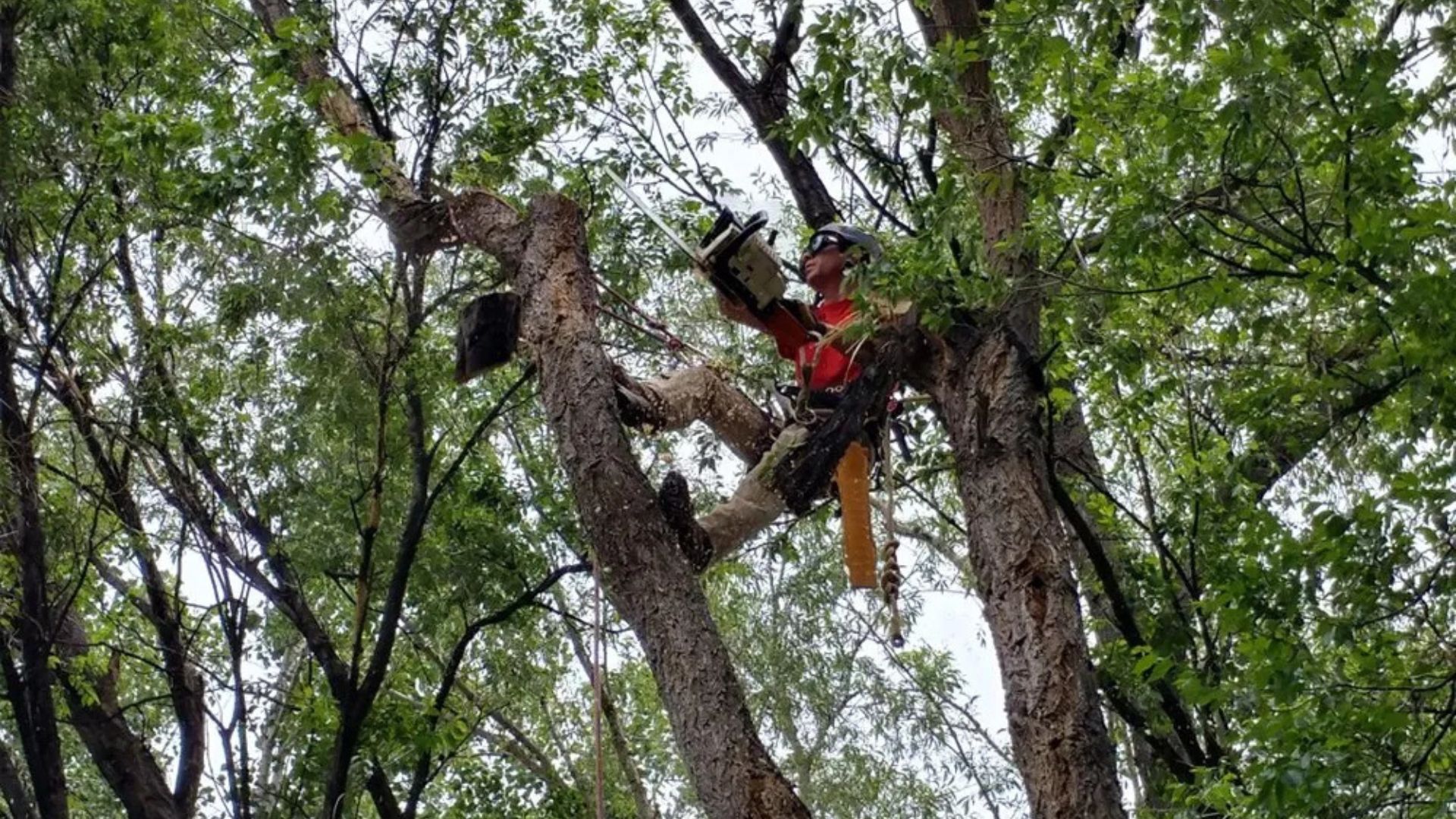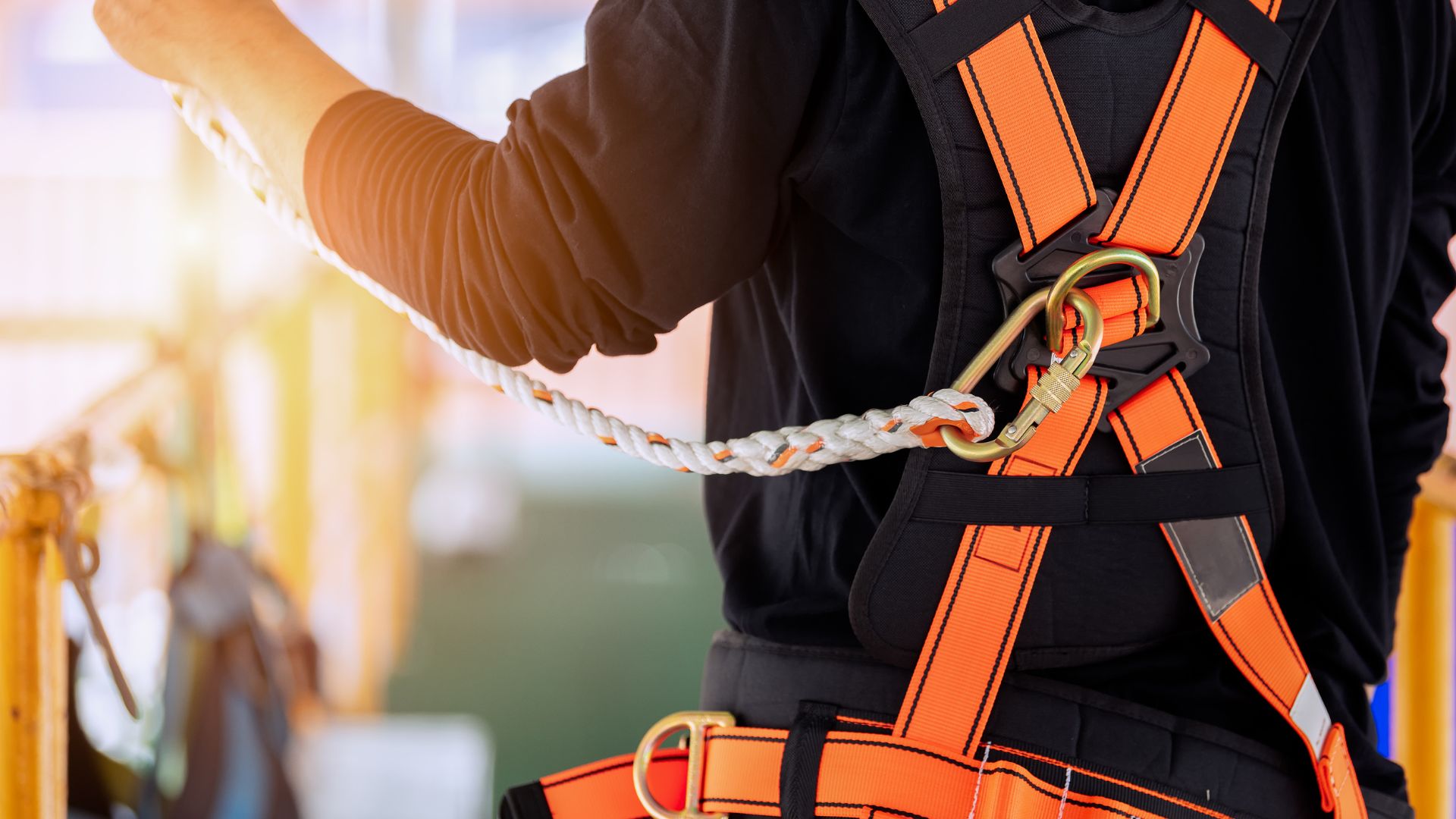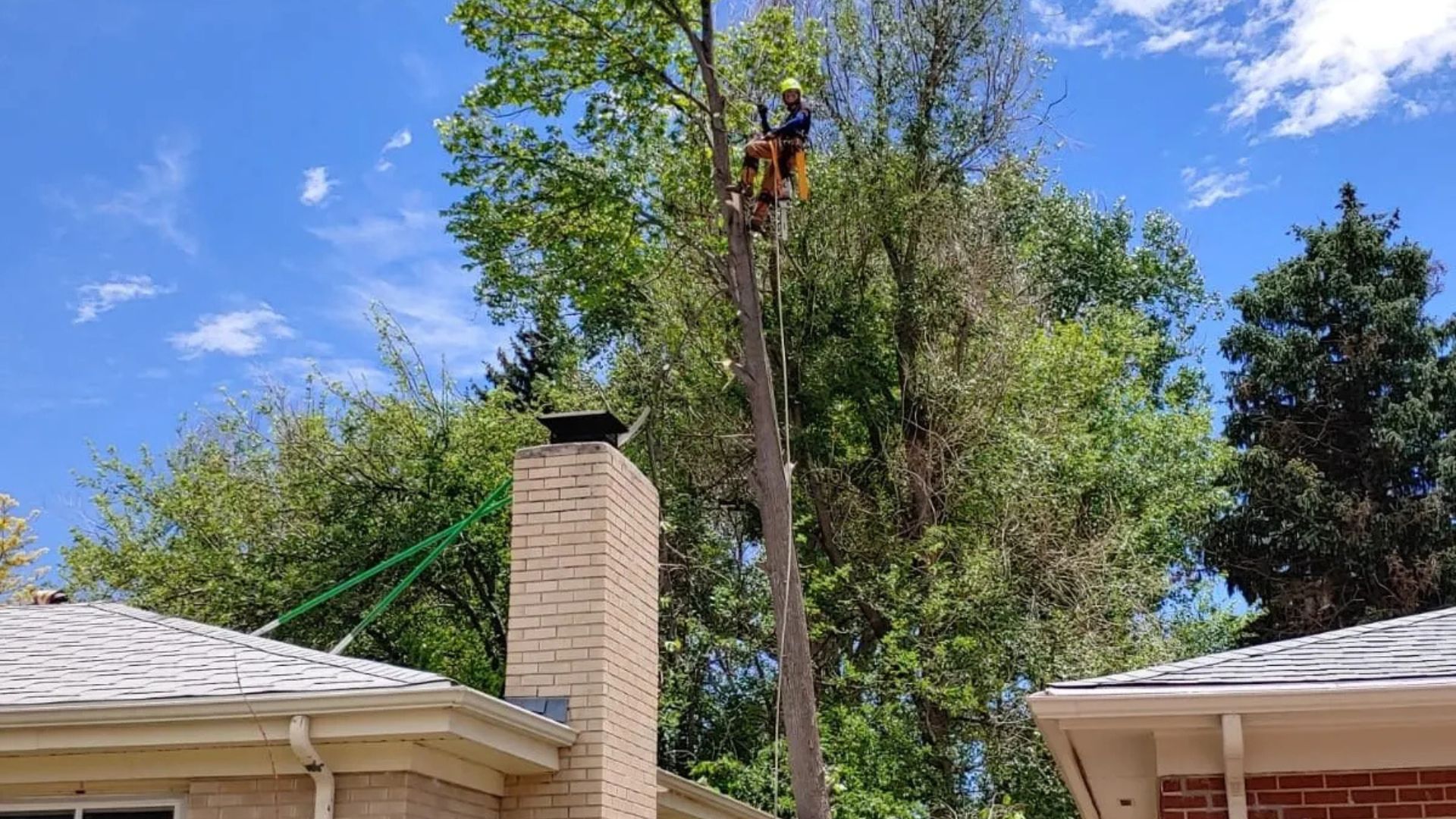When large trees threaten your Colorado Springs home or have become hazardous, your primary concern should be safe tree cutting. The best way to ensure safety is to hire a professional. The process involves much more than simply firing up a chainsaw and hoping for the best. With our region’s unique terrain, unpredictable weather patterns, and tight residential layouts, safe tree cutting techniques are essential to protect your property, your family, and your neighbors during the removal process.
Property Protection During Tree Removal
Colorado Springs presents unique challenges for tree work that many homeowners don’t consider until it’s too late. Our combination of high altitude, strong winds, and varied terrain creates special considerations for safe tree cutting operations.
Residential density challenges: Unlike more rural areas, many Colorado Springs neighborhoods feature homes built relatively close together. This proximity means that professional tree removal requires precise directional falling techniques and often specialized equipment to avoid damaging nearby structures.
Weather complications: Our famous Colorado winds can shift dramatically during tree removal operations, potentially changing the direction of fall. Professional crews monitor weather conditions carefully and may reschedule work if conditions could compromise safety.
Terrain considerations: With our foothills, slopes, and varied elevations, removing trees in Colorado Springs often requires additional precautions to account for gravity’s effects on falling trees. What might be a straightforward procedure on flat land becomes significantly more complex on the west side’s sloping properties.
Common Property Damage Risks During Removal
Knowing what is at stake is the first step toward ensuring safe tree cutting that protects your property and your loved ones.
Structural damage: Without proper techniques, falling trees or large limbs can cause catastrophic damage to homes, garages, fences, and other structures. According to Consumer Reports, property damage from fallen trees averages $4,110 per incident.
Landscape destruction: Improperly planned removal can destroy years of landscape investment in seconds. Gardens, smaller ornamental trees, irrigation systems, and hardscaping are particularly vulnerable during tree removal operations.
Utility disruptions: Trees falling into power lines don’t just create safety hazards—they can damage electrical systems, communication lines, and other utilities. Professional tree removal practices include thorough evaluation of all overhead and underground utilities before work begins.
Collateral property impacts: In tightly packed neighborhoods, the risk extends beyond your property lines. Without proper tree removal procedures, you could be liable for damage to neighboring homes, vehicles, or other assets.
You Might Like: 7 Signs Your Colorado Springs Property Needs Professional Tree Trimming
Professional Techniques for Safe Tree Cutting
Professional tree removal specialists employ several techniques to ensure property protection during tree removal.
Professional risk assessment: Before any cutting begins, professionals conduct a thorough inspection of the tree’s condition, lean, surrounding structures, and environmental factors. This assessment forms the foundation of a removal plan tailored to your specific situation.
Directional falling methods: When space allows, trained professionals use precise notching and back-cutting techniques to control precisely where and how a tree falls. According to some research, proper directional cutting techniques can improve accuracy by up to 85% compared to amateur approaches.
Sectional dismantling: In many Colorado Springs neighborhoods where space is limited, safe tree cutting requires removing the tree in small, manageable sections from top to bottom. This controlled approach is more time-consuming but dramatically reduces risk to the surrounding property.
Specialized equipment deployment: From crane-assisted removal to specialty rigging systems, professional tree services often employ equipment that can securely lower large sections of trees without impact damage to surrounding areas.
Ground protection protocols: During tree removal operations, professionals use ground protection mats, specialized vehicles, and strategic access routes to minimize impact on lawns, landscaping, and hardscape areas.

DIY vs. Professional Services: Understanding the Differences
Many homeowners consider tackling tree removal themselves, but understanding the differences in approach, equipment, and outcomes is critical before making this decision.
Safety training disparities: Professional tree service crews undergo extensive safety training and certification. The tree care industry faces a fatality rate up to 11 times higher than the average across all industries, often worsened by untrained tree removal.
Equipment limitations: Effective safe tree cutting requires more than a chainsaw from the hardware store. Professionals use commercial-grade equipment that is properly maintained and specifically designed for the challenges of tree removal. This includes specialized ropes, rigging hardware, tension systems, and personal protective equipment that most homeowners don’t have.
Insurance considerations: Professional tree services carry specialized insurance for removal operations that protects you from liability if something goes wrong. Homeowners’ policies often specifically exclude coverage for damage resulting from DIY tree work gone wrong.
Hidden hazards awareness: Professionals are trained to identify less obvious dangers during tree removal, including:
- Wood under tension that can spring violently when cut
- Structural weaknesses that are not visible from the ground
- Wildlife habitats that may create unexpected hazards
- Decay patterns that affect how wood behaves when cut
Seasonal Considerations for Tree Removal in Colorado Springs
They say timing is everything, and that is especially true when it comes to both the safety and effectiveness of tree removal operations in our region.
Winter advantages: The dormant season often provides ideal conditions for tree removal in Colorado Springs. With leaves absent from deciduous trees, weight is reduced, visibility improved, and structural issues easier to identify. Frozen ground can also provide better equipment stability and reduce landscape damage.
Spring cautions: Our notorious spring snowstorms can create additional hazards for tree work, as snow-loaded branches carry substantially more weight and may conceal hidden structural stresses. Additionally, the rapid weather changes typical of Colorado Springs can create unpredictable working conditions.
Summer heat factors: During the hot summer months, safe tree cutting procedures require additional precautions due to the potential for equipment overheating and worker fatigue, which can compromise precision and safety. Early morning scheduling becomes more important for complex removals.
Fall considerations: Autumn brings leaf drop that can obscure ground hazards during tree removal operations. However, it’s often an excellent time for removal work before winter storms arrive, particularly for trees already showing signs of potential failure.
Related: The Hidden Costs of Delaying Tree Removal in Colorado Springs
Preparation Steps for Professional Tree Removal
Proper preparation is essential for protecting your property during tree removal and tree trimming in Colorado Springs.
Clearance creation: Remove vehicles, outdoor furniture, potted plants, and other movable items from the potential fall zone before work begins. For items that can’t be moved, discuss protection strategies with your tree service.
Access planning: Safe tree cutting requires clear pathways for workers, equipment, and debris removal. Preparing these routes in advance—including potentially removing fence sections or gates—can significantly reduce property impact.
Neighbor notification: As a courtesy in our tight-knit Colorado Springs communities, inform neighbors about upcoming tree removal operations, particularly if large equipment will be used or if the tree is near shared property lines.
Utility marking: Before any significant tree work, have underground utilities marked through Colorado 811’s free service. This prevents potential service disruptions and dangerous line strikes during stump removal or ground operations.

Post-Removal Considerations
The tree removal process doesn’t end when the tree is down. Several post-removal factors affect both safe tree cutting and property protection.
Debris management: Professional tree services should include thorough cleanup protocols that protect your landscape from damage caused by dragging or dropping debris. Discuss how wood and branches will be removed from your property before work begins.
Stump handling options: Depending on your landscape plans, you may choose stump grinding or complete removal after the tree is cut. Each approach has different property impact considerations and should be discussed as part of your tree removal plan.
Soil and root zone restoration: Large tree removal creates voids in your landscape that may require soil amendments, filling, or reseeding. Professional services can advise on the best approaches to restore these areas safely.
Replacement planning: If you’ll be planting new trees after removal, safe placement away from structures, utilities, and hardscaping is essential to prevent future problems. Many Colorado Springs homeowners are unaware that placement is the most crucial factor in preventing future tree-related property damage.
The Safe Tree Cutting Advantage
When selecting a service provider for tree removal in Colorado Springs, Peak Tree Service offers several advantages that protect your property during the process.
Colorado Springs-specific expertise: Our team understands the unique challenges of safe tree cutting in the Pikes Peak region, from the effects of altitude on equipment performance to the specific soil conditions that affect stability during removal operations.
Property protection focus: We develop customized removal plans for each property, with specific emphasis on minimizing impact to your landscape, structures, and hardscaping. Our goal is safe tree cutting that leaves your property in better condition, not worse.
Comprehensive insurance: Our services are fully insured specifically for tree removal operations, providing you with peace of mind that your property is protected throughout the process.
Advanced equipment access: Our investment in specialized tree removal equipment allows us to handle challenging situations that might otherwise risk property damage with less-equipped providers.
Transparent communication: Safety and customer satisfaction both begin with clear expectations. Before work begins, we’ll explain exactly how the process will work, what protective measures we’ll implement, and what you can expect during each phase of the removal.
Keep Reading: What to Look for When Choosing the Best Tree Services in Colorado Springs
Taking the Next Step
Now that you understand the value of safe tree cutting techniques and professional expertise, you can make informed decisions about addressing problematic trees.
If you have trees of concern, start with a professional evaluation to determine whether removal is necessary, or if alternative interventions might be more suitable. Not all concerning trees require removal, and a qualified assessment can save you both money and valuable landscape assets.
Remember that in Colorado Springs’ unique environment, professional tree removal isn’t just about eliminating a problem—it’s about doing so in a way that protects your entire property investment. With proper planning and expert execution, even large tree removal can be accomplished with minimal impact to your landscape and structures.
When you’re ready to discuss safe tree cutting for your Colorado Springs property, schedule your free tree evaluation. We will meet on your property at a convenient time to evaluate your trees and develop a removal plan that prioritizes safety and property protection.

